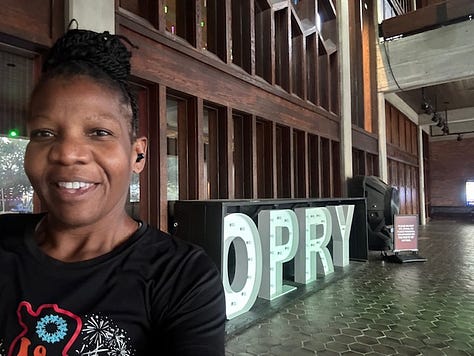
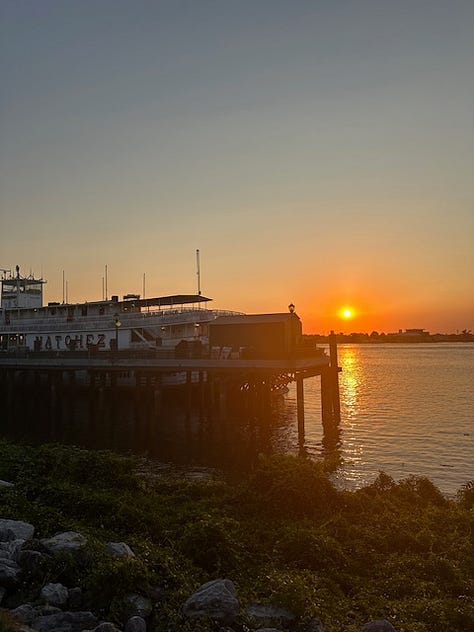
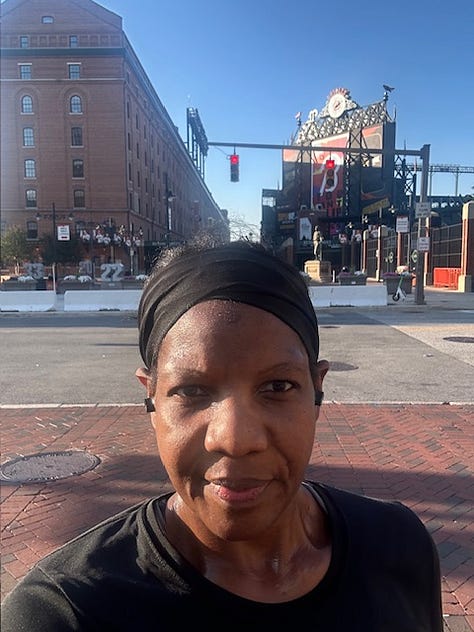
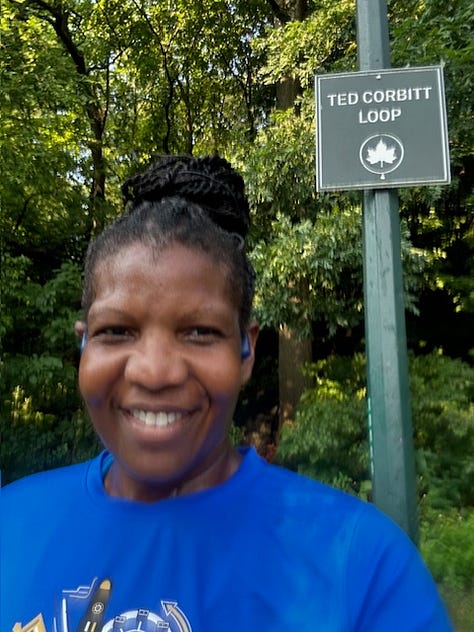
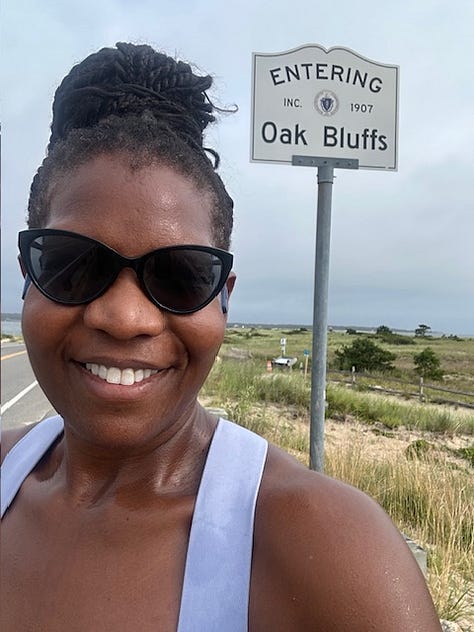
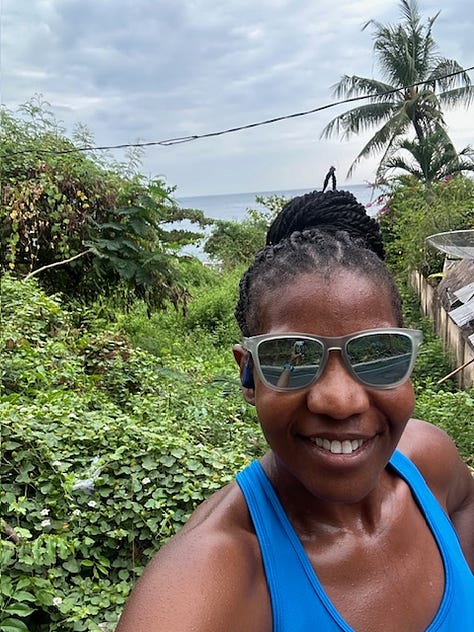
Picture Description: A compilation of places the writer has visited and run through over the past 6 months—top row from left to right: Nashville, New Orleans, Baltimore. The bottom row from left to right is NYC, Oak Bluffs, and Bali.
Check-In:
One of the many things running gives me is the ability to see a new place on foot. I make an effort to run outside every place that I travel. Something about meandering down streets gives me a view into a place that cannot be seen through a curated tour. I’m always wondering about the neighborhood's history, how it has changed over time, and if my presence as a Black woman running through it symbolizes protest.
I’m currently reading The Message by Ta-Nehesi Coates which talks about his approach to writing and his role as a writer seeking liberation and it uses his travels to Senegal, South Carolina, Israel, and Palestine as foundations for his reflections. The book reminds me of two other books I’ve read in the past few years- South to America: A Journey Below the Mason-Dixon to Understand the Soul of a Nation by Imani Perry and How the Word Is Passed: A Reckoning with the History of Slavery Across America by Clint Smith. In each book, the writer travels to multiple locations to reflect, tell a story, make connections, teach history, and evoke emotions.
Reading the book reminds me how in recent months I’ve talked to educators in Ghana, Thailand, and Germany and how ‘place’ impacts their experiences, beliefs, and approaches to teaching and learning. I think about school leaders like Rictor Craig at Statesmen College Preparatory Academy for Boys who integrate travel as a part of their curriculum. I remember being a teacher in NYC and even taking the subway to a different borough was new to some of my students as we know that Brooklyn is not the same as Manhattan.
Place connects people to a dialect, dress, food, and outlook on the world that is a source of pride (see Texas) but can also feel like a grip that is hard to get out of, especially if the place was curated to oppress (see redlining).
On a recent “If I Ruled the World” episode of the podcast,“What Now”, co-host Christiana Mbakwe Medina said if she ruled the world she would require yearly government-funded travel for every person in the country. She believes that showing people how other cultures live will change their worldview. I would live in Christiana’s world.
I know I have the financial privilege of getting to learn from places all across the globe. I also recognize all travel isn’t created equal. I was just at a resort in Nashville where I never had to leave the grounds if I didn’t want to. This was the same experience in Bali where we spent a night at a beachfront hotel. It was lovely but I couldn’t tell if I was in Indonesia or Miami. Travel also can lead to a type of colonialism which I saw in Ghana where visitors are buying up affordable land for their own financial benefit. There’s an approach to travel that honors the place. The goal must be to understand its history, learn from its native peoples, and honor the past and current movements toward liberation. That is an intentional choice.
How are you providing opportunities for yourself, students, and others to learn from other places?
#mondaymotivation: “Go and see.” -Ta-Nehesi Coates
Interview with a Leader of the Global Majority:
Danielle was the Director of Equity and Diversity for a large district in Florida for over two years. The comments below are Danielle’s and do not reflect the opinions of her school system. You first heard from Danielle in Issue 25: School. Below is a new excerpt.
Mary: How do you cultivate buy-in from within and outside your district?
Danielle: In our county, the community is represented in the district’s workforce. We're the second largest employer here and we have 70,000 or so students.
Danielle: And so what I find is that there are parents, there are community members that have always been able to have a very prominent voice and approving or denying and, or not supporting some of the good work that we want to do.
Danielle: What I like to do is hit people with the data. If you're so opposed to my work, if you're so opposed to what we're trying to do as a district, let's first look at the data, let's first understand the why, and connect that to the who.
Danielle: And so when you see that there are disparities for our black and brown students in their achievement and, or the representation of staff members that we have in the district, this should be enough for you to understand the why.
Danielle: But then in this politically conservative community that I'm serving in, and again, with the national criminalization of what equity work is, and of course the whole CRT piece in it, it's just a constant barrier to being able to do what is necessary.
You can read more from Danielle in “Leading Within Systems of Inequity in Education: A Liberation Guide for Leaders of Color”. Let me know if you would like to be interviewed and/or recommend someone to be profiled in this section.
What I’m Reading, Watching, and Listening To:
READING: I’m currently reading The Message by Ta-Nehesi Coates which has led me to seek out all his interviews and others’ perspectives on his latest book of essays. I often disagree with the perspective of NY Times columnist John McWhorter which is why I read him. In this opinion piece, he unpacks the interview between CBS co-anchor Tony Dokoupil and writer Ta-Nehesi Coates. You can find a full list of my book recommendations here. Please note that I am an affiliate with Bookshop.org and receive a small compensation for your purchase when you use the book links provided.
LISTENING & WATCHING: Ta-Nehesi Coates’s interview on CBS has been the basis for a lot of debate. His reflections on the interview were part of his conversation on the What Now podcast with Trevor Noah.
How to Continue to Support Leading-Within:
Go to Amazon and rate or review the book there! Reviews are a great way for others to see that this book is worth the time to read.
Post about the book on social media using the hashtag #leadingwithin. Even better if it includes a picture of you WITH the book!
Host a book club with your affinity/ERG group. Two study guides are also available on the ASCD website - one for leaders of color and one for white co-conspirators that are perfect for starting a group conversation. For book clubs with participants who have purchased and committed to reading the book, please reach out to me so I can support your journey!
Connect with me to speak to your organization or group about topics covered in the book, like ‘practicing love and rage’, ‘building a coalition’, and ‘taking a stand’.
If this is your first time reading, please go back and read my Introductions post.
Thanks for reading! Let me know what you think. If you like it, please share it with your network!



